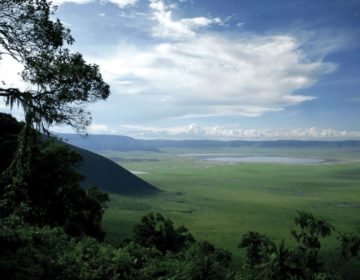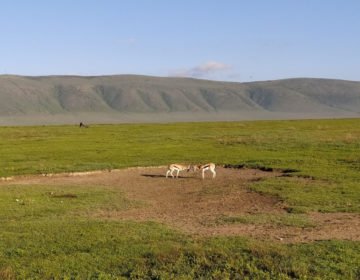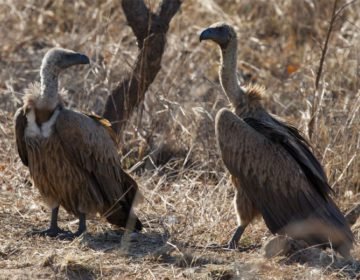All our 6-day Africa wildlife safaris, specifically include the Ngorongoro Conservation Area and the world famous Ngorongoro Crater National Park in Tanzania. This specific Africa safari and travel itinerary has been designed for visitors with more time on hand for a longer safari or travel tours. It specifically includes the Tarangire National Park and have been designed to offer you a total Tanzanian northern circuit safari experience, while keeping your non game-viewing travel time to a minimum.
Day 1: Lake Manyara National Park
Distance: 130 km
Pick up from Arusha and transfer to Lake Manyara national park.
We arrive in time for lunch at the lodge and after lunch do we head into the Lake Manyara National Park for an afternoon game drive. This national park is one of Tanzania’s most dramatically located wildlife areas, consisting of a massive but shallow soda lake (covering two-thirds of the park), located at the foot of the Great Rift Valley’s western escarpment. The park’s varied habitat attracts a wide variety of animals, including one of Africa’s largest concentrations of elephants, Lake Manyara’s unique tree-climbing lions, as well as large flocks of flamingos attracted by the algae in the lake.
Day 2: Lake Manyara – Serengeti Plains
Distance: 205 km
After breakfast we head towards the Serengeti National Park, via the beautiful high lying farmland of Karatu and the Ngorongoro Conservation Area. Leaving the highlands behind, we descend into the heart of wild Africa – the Serengeti National Park – with its endless plains, rolling into the distance as far as the eye can see. We head to the central park area, known as the Seronera area, one of the richest wildlife habitats in the park, featuring the Seronera River, which provides a valuable water source to this area and therefore attracts wildlife well representative of most of the Serengeti’s species.
We arrive in time for lunch and enjoy an afternoon game drive in the Serengeti national park.
Day 3: Serengeti Plains
We do an after breakfast game viewing drive along the Sogore River Circuit, which loops into the plains south of the Seronera River, and which is good for possible Lion, Thomson gazelle, topi, ostrich and cheetah sightings. The Visitor Centre close to the Serengeti Seronera Lodge and public campsites, is well worth a visit after the morning’s game drive. This nicely designed centre offers some interesting wildlife displays as well as a gift shop selling information leaflets and maps of the area. The centre also has a shop where cold drinks and snacks can be purchased, as well as a picnic area and information trail up and around a nearby kopje. We will enjoy a relaxed picnic lunch at the centre in the shade of the giant acacia trees.
In the afternoon we will follow the Kopjes Circuit, which goes anti-clockwise around the Maasai Kopjes, which usually attract a number of lion and some formidably large cobras. Kopjes are weathered granite outcrops, scattered around the plains, most of which are miniature ecosystems, providing shade and drinking water in pools left in the rock after the rains. This makes the kopjes particularly good for spotting wildlife in the dry seasons – including lions, which like to lie in wait for animals coming to drink!
Day 4: Serengeti Plains – Ngorongoro crater
Distance: 145 km
After breakfast at the lodge do we depart to Ngorongoro Conservation area. We will stopover at Olduvai Gorge, boasting with a history dating back to the dawn of time. It was here, that the anthropologists Drs. Lois
and Mary Leakey discovered the skulls of ‘Nutcracker Man’ and ‘Handy Man’, both very significant links in the chain of human evolution.
We arrive in time for lunch at the lodge and after lunch we will descend over 600 meters into the crater to view wildlife for a half day’s safari tour. Supported by a year round water supply and fodder, the Ngorongoro National Park supports a vast variety of animals, which include herds of wildebeest, zebra, buffalo, eland, warthog, hippo, and giant African elephants. Another big draw card to this picturesque national park, is it’s dense population of predators, which include lions, hyenas, jackals, cheetahs and the ever-elusive leopard, which sometimes requires a trained eye to spot. We will visit Lake Magadi, a large but shallow alkaline lake in the southwestern corner, which is one of the main features of the crater. A large number of flamingos, hippos and other water birds can usually been seen here.
Day 5: Ngorongoro Crater – Tarangire National Park
Distance:155 km
After breakfast we depart for the Tarangire National Park. The park runs along the line of the Tarangire River and is mainly made up of low-lying hills on the Great Rift Valley floor. Its natural vegetation mainly consists of Acacia woodland and giant African Baobab trees, with huge swamp areas in the south. Both the river and the swamps act like a magnet for wild animals, during Tanzania’s dry season. The Tarangire National Park is reputed to contain some of the largest elephant herds in Africa. This African national park is also home to three rare species of animals – the Greater Kudu, the Fringed-eared Oryx, as well as a few Ashy Starlings. After a picnic lunch we do an afternoon game drive.
Day 6: Tarangire National Park – Arusha
Distance: 120 km
We enjoy breakfast at the lodge and then transfer back to Arusha. Upon arrival in Arusha will we have lunch and then we will end our African safari adventure.





